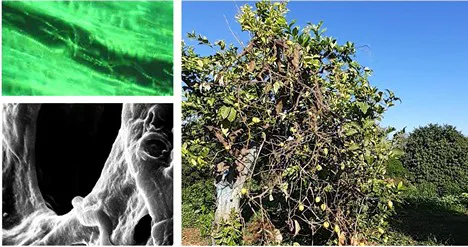"Mal secco has been affecting lemon cultivation in the Mediterranean area for over one century, with particularly serious economical and occupational repercussions in Italy. Just think that, between 1986 and 2017, lemon groves dropped by 45% and production dropped by 41%," explains Antonino Catara, Professor of Vegetable Virology and Pathology at the University of Catania and currently scientific consultant for Agrobiotech.
"The diffusion of new varieties, clones and grafts, the extension of the crop in areas with lower experience, the withdrawal from commerce of a few crop protection products effective for the containment of the pathogen, the limitations in the use of copper products and the cost of pruning interventions have progressively reduced the basic preventive measures. At the same time, the inoculation load has increased and soils have become a reservoir for the pathogen."
 Antonino Catara
Antonino Catara
"In the meantime, research has provided useful information to activate new preventive measures that would have to be validated in the open fields. While we wait for genetics to enable the access to tolerant (if not resistant) varieties and rootstocks and for the chemical industry to develop products suitable to spread into the xylem tissues of the pathogen, it has been ascertained that a few preparations stimulate the resistance mechanisms of plants against various pathogens, representing an alternative to chemical treatments for the management of mal secco."
"In addition, it has been confirmed that the fundamental point is the containment of the inoculation load in the foliage and in the soil with integrated, shared and informed methods. We need to train operators, supplying them with basic notions and modern tools, set up a communication system to favor the development of a widespread technical-scientific culture. This plan requires the active participation of producer organizations to implement measures to reduce inoculation via differentiated pruning functional for the objective - the elimination of brushwood and the inactivation of leaf litter."

Mal secco symptoms and pathogen movement in tree vessels
"We need to guide the informed application of biostimulants to the ground and/or leaves to favor the development of beneficial micro-organisms that improve the resistance of plants to biotic and abiotic stresses. Some of these products, which are suitable for organic cultivation, revitalize plants and the root system and help slow down infective processes and reduce pruning interventions. Preventive phytosanitary measures need to be carried out properly in nurseries so as to guarantee the health of the grafts and rootstocks to be used for new trees; discourage the use of varieties/clones and rootstocks too susceptible in areas affected by the pathogen with the support of a correct spreading of the most recent knowledge; implement passive protection measures against events that favor the development of the pathogen. Of course such an articulated plan requests the active participation of organization and careful and shared coordination."
For further information:
Prof. Antonino Catara
[email protected]










